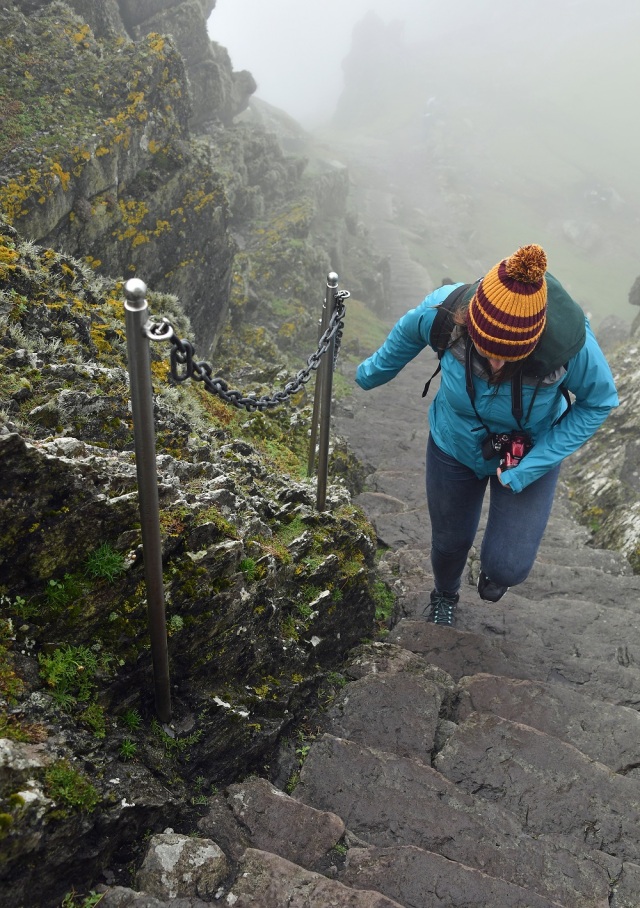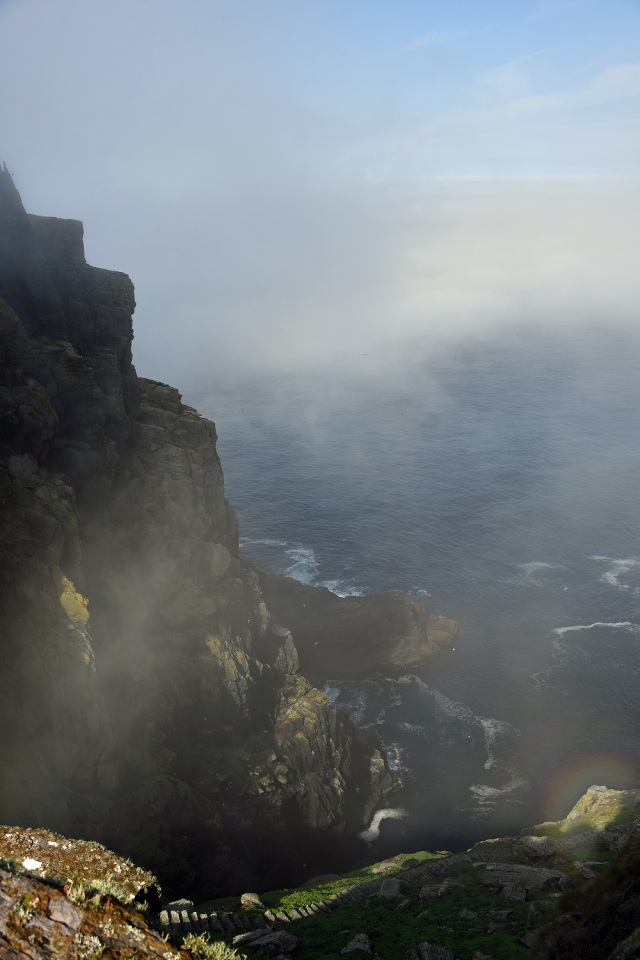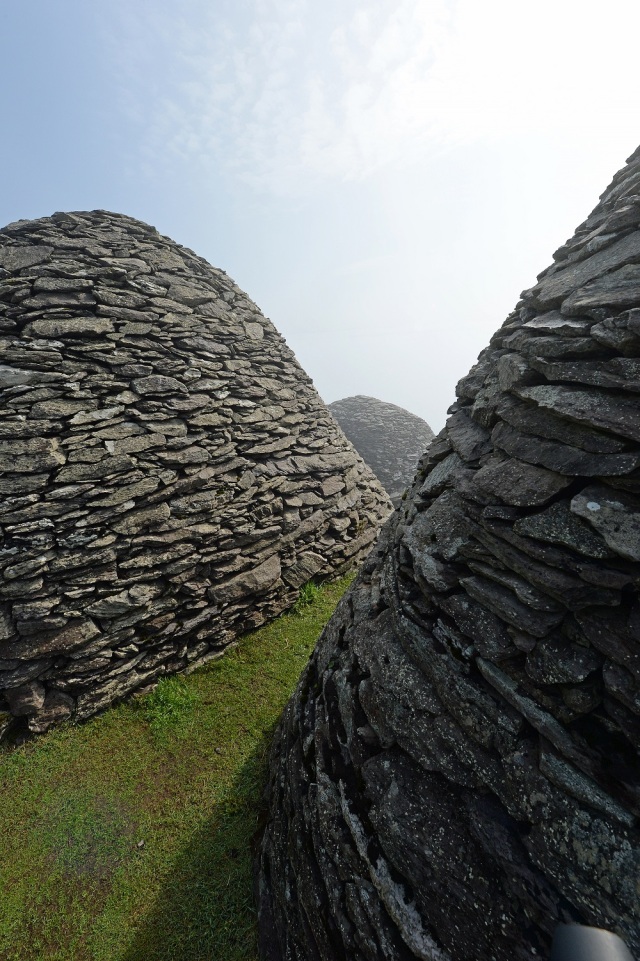
Skellig Michael as seen from a boat
The Skelligs
Skellig Michael is a steep, rugged, twin-peaked crag located 11.6 k m off the west coast of county Kerry, Ireland. The reason why you want to go to Skellig Michael is to visit the well-preserved monastic settlement built 600 feet above sea level. And of course, if you’re a Star Wars fan, to see the locations used in “The Force Awakens” and “The Last Jedi.” The only Jedis in evidence on Skellig Michael will be those who dress in the part during their visit.
Travel
The route out to the Skelligs is via boats licensed by the Irish Office of Public Works (OPW), which travel from places like Portmagee from May to October. Even if you book with a licensed operator, the vagaries of the weather mean that you can never be sure that you’ll get to the island. The OPW might close the island if the weather is too severe and boats will not go across if the sea conditions are too rough.

Typical boat used to travel to Skellig Michael. Note the swell – and this is on a day with little wind.
In our case, we were lucky to travel on a day between two bad days. Even so, the conditions varied enormously from clarity in Portmagee through a transit in a sea mist with visibility down to 50 meters before we landed. During the two and a half hours allocated on the island, the mist gradually cleared but never disappeared totally. The ride back was in bright sunshine and some on the boat were sunburnt when they got back to port.
Selecting an Operator
A variety of operators are available. Among the questions you might ask before you commit to one are:
- Is cover available in the boat in case of rain during the transit?
- What facilities are available on the boat? For instance, a working and clean toilet.
- How long does it take to get to the Skellig? Our boat was slow and was passed by many others. This might be important if you are prone to seasickness. We took 75 minutes on the outward leg and a little longer on the return. The extra time was accounted for by a visit to Skellig Bheag (“little Skellig”), an uninhabited twin of Skellig Michael where landings are not allowed. Skellig Bheag supports a colony of 60,000 gannets and some seals.
- How much does the trip cost and how can you pay? We paid a deposit of EUR20 each online via credit card to reserve the trip, but then had to pay the balance in cash on the boat. The ticket mentioned this point, but it’s easy to forget to have EUR80 each after you make a booking many months in advance. There is no ATM available in Portmagee if you turn up without cash.
Overall, you should expect to spend about six hours travelling to and from Skellig Michael and the time on the island.

The landing place at Skellig Michael. It’s not always this calm and sunny.
Walking on Skellig Michael
The weather can change dramatically on Skellig Michael. Remember, you’re out on a rock in the Atlantic Ocean. As such, make sure that you wear appropriate clothing and can deal with rain, sun, wind, and a combination over a short period.
Good footwear is critical because much of the climb up to the monastic settlement is over roughly-hewn medieval stones set into a steep gradient. The initial phase from the landing point via the helicopter pad lulls you into a false sense of security because it’s over a well-made path that doesn’t cause any concern.

Climbing up a typical section of rough-hewn steps

Chain support – but only in two places
Support chains are available to hold in two places on the climb, but you’re on your own for the vast majority of the ascent. Many people bring ski poles or sticks to support themselves.

Descending from Christ’s Saddle

Looking down from Christ’s Saddle towards the original landing point
The Monastic Settlement
The settlement dates from about the 6th century and was occupied until the 12th or 13th century. It features six beehive-type cells, two oratories, and a church together with walls, slabs, and crosses. The settlement has been a world heritage site since 1996.

The great cross and cells

Oratory and what might be slabs marking a burial ground

Two of the cells showing details of their dry-wall construction

Walls protecting the settlement – the Macgillycuddy Reeks peer out the the mists in the distance with the peak of Skellig Bheag closer

View of Skellig Bheag rising from the sea mist as seen from the monastic settlement
It’s easy to spend 90 minutes or more investigating the different aspects of the settlement, including the system used by the monks to trap rain for their freshwater supply. The area can be crowded but patience and good humor makes sure that everyone gets the photos they want.
There are no bathrooms or other facilities on Skellig Michael. Anything you want has to brought with you, and if you’re taken short you’ll have to find somewhere safe and discreet to do your business.
The Descent
It’s physically harder to climb up to the settlement but it can be as demanding to descend back to the landing place. The steepness becomes more apparent, especially on the walk down from Christ’s Saddle when you can see the open sea beneath you.

View from the Wailing Woman rock towards the landing point with Skellig Bheag shrouded in mist. Note the boats waiting to come in to pick people up from the island.

Some of the amazing scenery on the descent (it was too misty to see this on the ascent)
For those interested in fitness trackers, I registered about 6,500 steps on Skellig Michael, and my device told me that I had gone up the equivalent of 85 stairs. Anyone in reasonable physical condition will be able to make the climb, provided that they take their time and pay attention to where they place their feet.
Return via Skellig Bheag
On the return, most boats travel around Skellig Michael to see the lighthouses (original and new) and the original landing place used by the monks before heading across to Skellig Bheag. The estimate is that 60,000 gannets use Skellig Bheag as their nesting place before they head south in September. The smell of so many gannets is quite something, as we discovered when we arrived downwind of the island.

Some of the 60,000 gannets in residence on Skellig Bheag
You can also see grey Atlantic seals on Skellig Bheag.

Grey Atlantic seals
The last sight before turning back for the mainland was the view of the Elephant’s Trunk on Skellig Bheag with Skellig Michael in the background.

The Elephant’s Trunk
Worth the Trip
A trip to Skellig Michael is absolutely worth it. Go in June or July if you want to see the Puffins (they had all departed when we were there). Make sure that you are well-equipped for the weather and the climb and remember to bring water and something to eat. Sea bands or tablets can help to avoid seasickness on the rides out and back from the island, and when you get back ashore have a pint to celebrate seeing something that’s very unique.

